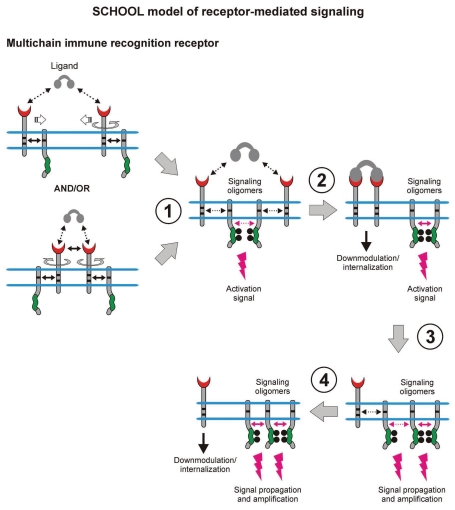Figure 6.
Within the model, formation of competent signaling oligomers in cytoplasmic milieu is necessary and sufficient to generate the activation signal, thus triggering downstream signaling pathways. Ligand-induced MIRR clustering and reorientation (in pre-existing MIRR clusters, ligand binding induces receptor reorientation) lead to formation of a dimeric/oligomeric intermediate (stage 1). In this intermediate, receptors are in sufficient proximity and adopt the correct (permissive) relative orientation and geometry to promote trans-homointeractions between cytoplasmic domains of signaling subunits resulting in formation of competent signaling oligomers. Upon formation of signaling oligomers, PTKs phosphorylate the tyrosine residues in the cytoplasmic signaling motifs, the immunoreceptor tyrosine-based activation or YxxM motifs (ITAMs/YxxM, shown by green), that leads to generation of the activation signal, dissociation of signaling oligomers and internalization of the engaged binding subunits (stage 1). Next, the signaling oligomers sequentially homointeract with the relevant signaling subunits of nonengaged receptors resulting in formation of higher-order signaling oligomers, thus propagating and amplifying the signals (stages 3 and 4). This also leads to the release and subsequent internalization of the nonengaged ligand-binding MIRR subunits (stage 4). Circular arrows indicate ligand-induced receptor reorientation. Black and magenta arrows indicate specific intersubunit hetero- and homointeractions between transmembrane and cytoplasmic domains, respectively. All interchain interactions in a dimeric intermediate are shown by dotted arrows reflecting their transition state. Curved lines depict intrinsic disorder of the cytoplasmic domains of MIRR signaling subunits. Phosphate groups are shown as dark circles. Abbreviation: PTK, protein tyrosine kinase; SCHOOL, signaling chain homooligomerization.

